“1991 Technical Slide Set”, 1991
Title:
- 1991 Technical Slide Set
Year:
- 1991
Conference:
Description:
Edited by:
Eric Bosch
McMaster University
Juried by:
Joe Cychosz
Purdue University CADLAB
Rich Ehlers
Evans and Sutherland
Robert L. Judd
Los Alamos National Laboratory
Alan Paeth NeuralWare, Inc.
Thomas W. Sederberg Brigham Young University
SIGGRAPH ’91 Technical Slide Set Credits
Edited by Eric Bosch
SIGGRAPH ’91 Slide Sets Chair
Diana Tuggle
SIGGRAPH Visual image Editor
The technical slide set represents the state-of-the-art in computer generated images. This year’s set has 78 slides. Each slide is printed here in black and white to facilitate locating information about the images. The full color 35mm slide set can be ordered from: ACM order department, P.O. Box 64145, Baltimore, MD 21264; 1-800-342-6626. The ACM order number for the SIGGRAPH ’91 technical slide set is 915910. The cost is $33 for members; $44 for non-members.
1. DIB-200 Atrium by Shinichi Kasahara, A. Scott Howe. The image was computed at a resolution of 2048 x 1376. The number of point light sources is 212, and the number of polygons is about 41,000. Calculation time was about nine hours. Modeling was on an IBM 3090 mainframe using a CA TIA 3D CAD system. Rendering was on a MAGIC high-speed graphics engine using REALS in-house ray tracing software. Contact: Shinichi Kasahara, Kajima Corporation Information Processing Center, 6-5-30 Akasaka Mianto-ku, Tokyo 107, Japan; (03) 5561-2403.
2. IBM 3600 Steeles Atrium by Mary Lynn Machado. The architectural and background information were created using Alias 3D. The trees were created using AMAP 3D plant generating software. AMAP, running on SGI workstations, creates biologically correct plant species. Lighting and POV’s were matched to the Alias image. The trees were rendered in AMAP and composited with Alias. Alias Version 2.4.2, AMAP landscape software was used on SGI 4D/25, SGI 4D/70 and IBM RISC 6000 equipment. Contact: Mary Lynn Machado, Design Vision Inc., 479 Wellington St. West, Toronto, Ontario, Canada M5V 1E7; (416) 585-2020.
3. Pond by Brian Yen. The image shows dynamic wave simulations for a rainy night and was created using Sunvision on a Sun 4/470. Contact: Brian Yen, Sun Microsystems Inc., 2550 Garcia Ave., Mountain View, CA 94043-1100; (415) 336-6509.
4. Neural Network Reconstruc- tion by Rei Cheng. This is a side view, 3D reconstruction of several neurons within a balance organ of the inner ear, based on tracings from 234 serial section electron micro- graphs. The research addresses issues related to space and motion sickness problems. A Ross 2.2 system developed at NASA Ames was used on a SGI 4D/VGX, Dunn 635 camera. Contact: Rei Cheng, Biocomputation Laboratory MS-239-11, NASA Ames Research Center, Moffett Field, CA 94035.
5. Chimera by T.A. Larsen, D.S. Goodsell. Three independently solved DNA-ligand complexes were combined into a single chimeric structure to illustrate three types of interactions with DNA. The image was created on an Evans and Sutherland PS390 using Raster Molecular Surface software. Contact: T.A. Larsen,. Molecular Biology Institute, University of California at Los Angeles, 405 Hilgard Avenue, Los Angeles, CA 90024-1570; (213) 206-8270.
6. Chromasomes during Cell Division by Julie Newdoll, Hans Chen, David Agard. The image shows a transparent ray traced half of a mitotic spindle during anaphase. Blue = chromasomes, green = centromeres, magenta = newly discovered protein. It was created using Presolid and Rendach (uses Dore) on a Stardent Titan and VAX. Contact: Julie Newdoll, University of California at San Francisco, Department of Biochemistry, P.O. Box 0448, San Francisco, CA 94143-0448; (415) 665-1428.
7. Fountain Closeup by Melvin L. Prueitt. This is a closeup view of fountain in “A Garden on Vega Nine.” Water film and streams follow appropriate gravitational trajectory. The image was created on a Cray YMP and Dicomed film recorder using SCOPE, the author’s own program. Contact: Melvin L. Prueitt, C-6 Computer Graphics, MS-B272, Los Alamos National Laboratory, Los Alamos, NM 87545; (505) 667-4452.
8. Stage View – Candlestick Theater by Dan Baum, Steve Mann, Kevin Smith, Jim Winget, Mark Mack, Charles Ehrlich (UC Berkeley). This image was generated using techniques from the paper entitled “Making Radiosity Usable: Automatic Preprocessing and Mesh- ing Techniques for the Generation of Accurate Radiosity Solutions.” It was created on a SGI 4D/320VGX using prototype radiosity preprocessing, solution and viewing software. Contact: Dan Baum, Silicon Graphics, 2011 N. Shoreline Blvd., MS7U- 550, Mountain View, CA 94039-7311; (415) 962-3671.
9. Auditorium View Candlestick Theater by Dan Baum, Steve Mann, Kevin Smith, Jim Winget, Mark Mack, Charles Ehrlich (UC Berkeley). This image was generated using techniques from the paper entitled “Making Radiosity Usable: Automatic Preprocessing and Meshing Techniques for the Generation of Accurate Radiosity Solutions.” It was created on a SGI 4D/320VGX using prototype radiosity preprocessing, solution and viewing software. Contact: Dan Baum, Silicon Graphics, 2011 N. Shoreline Blvd., MS7U550, Mountain View, CA 94039-7311; (415) 962-3671.
10. Brooks’ House Living Room by Dan Baum, Steve Mann, Kevin Smith, Jim Winget. This image was generated using techniques from the paper entitled “Making Radiosity Usable: Automatic Preprocessing and Meshing Techniques for the Generation of Accurate Radiosity Solutions.” The building model is copyrighted by UNC at Chapel Hill. It was created on a SGI 4D/320VGX using prototype radiosity preprocessing, solution and viewing software. Contact: Dan Baum, Silicon Graphics, 2011 N. Shoreline Blvd., MS7U-550, Mountain View, CA 94039-7311; (415) 962-3671.
11. Visibility Analysis of a Front Loading Work Cycle by Mark Bajuk, David Cooper (Caterpillar, Inc.). A combination of viewing windows, from a “multi-eyed” wide angle camera to a flat shaded bucket- tracking camera, are used to analyze the visibility of a backhoe front bucket during a truck-loading work cycle. The image was created on a SGI 4D/240GTX using Wavefront Technologies and various in-house visualization software. Contact: Mark Bajuk, NCSA at the University of Illinois at Urbana-Champaign, 605 E. Springfield Ave., Champaign, IL 61820; (217) 244-1966.
12. The Light Bulb Shadow Test by Mark Bajuk, David Cooper (Caterpillar, Inc.). The image shows a computer graphic recreation of the light bulb shadow test. A bulb is placed at the vehicle operator’s eye point, casting cones of light out through the windows.of the cab. The image was created on a SGI 4D/240GTX using Wavefront Technologies and various in-house visualization software. Contact: Mark Bajuk, NCSA at the University of Illinois at Urbana- Champaign, 605 E. Springfield Ave., Champaign, IL 61820; (217) 244-1966.
13. Hypersurface Projection Graphs by T. Foley, G. Nielson, D. Lane. A new method for modeling a hypersurface defined on a surface is visualized using orthogonal, radial and three 4D hypersurface projec- tions. The image was created on a SGI 4D/340VGX using the author’s original software. Contact: T. Foley, CAGD Research Group, Computer Science Department, Arizona State University, Tempe, AZ 85287-5406; (602) 965-3190.
14. Visualizing Criminal Data by Barnhill, Foley, Lane, Woodland. A visualization of self control as a function of manic, depression and psychopathic deviance is shown. The image was created on a SGI 4D/ 340VGX using the author’s original software. Contact: Wayne B. Woodland, CAGD Research Group, Computer Science Department, Arizona State University, Tempe, AZ 85287-5406; (602) 965-3190.
15. Cloth Draping Simulation (0, 4.5, 9, 14) by David Breen, Donald House, Phillip Getto. This slide represents four instances in a draping cloth simulation using a particle- based modeling technique. The image was created on a DECstation 3100 and SGI 4D/60 using The Clockworks. Contact: David E. Breen, Rensselaer Design Research Center, CII 7015, RPI, Troy, NY 12180-3590; (518) 276-6482.
16. A Leather Cushion by Sabine Coquillart. This slide shows the Extended Free-Form Deformation technique. A leather cushion obtained by deforming a surface of revolution is shown. The image was created on a SGI 4D/20 using ACTION 3D. Contact: Sabine Coquillart, INRIA, Domaine de Voluceau, BP 105, 78153 Le Chesnay Cedex, France; (33) 1-39-63-54-23.
17. Hair by Andre Leblanc, Arghyro Paouri, Nadia Magnenat Thalmann, Daniel Thalmann. This is a hair generation using pixel blending (about 80,000 hairs per character). The image was created on a SGI 4D/240 VGX using Human Factory, Hairdresser. Contact: Daniel Thalmann, Computer Graphics Lab, Swiss Federal Institute of Technology, CH-1015 Lausanne, Switzerland; 41-21-693-5214.
18. Hairdressing Simulation by Ken-ichi Anjyo, Yoshiaki Usami, Ryozo Takeuchi. A simple deformation model of cantilever beams brings variations of hairdo, along with an anisotropic reflection model for 3D curves. The image was created on a SGI 4D/210VGX using in-house software for human action generation. Contact: Ryozo Takeuchi, Hitachi Research Laboratory, Hitachi Ltd., 4026 Kuji- cho, Hitachi-shi, Ibaraki-ken 319-12, Japan; 81-294-52 5111.
19. Phase Portrait by Scott A. Bums. This image presents a phase portrait and time parameterization of an autonomous differential equation, produced using an operational method called the “Newton transform” (Physica D, 37 (1989) 83-90). The Newton transform generates integral curves with no propagated error by identifying constants of motion – even in non-conservative systems where energy integrals produced by quadrature do not exist. It was created on a Macintosh and Matrix Slide Writer using custom Fortran. Contact: Scott A. Bums, University of Illinois at Urbana-Champaign, 104 S. Mathews #117, Urbana, II 61801; (217) 333-1618.
20. Garish by Gordon Lescinsky. The image shows linear fractals with partially randomized production rules rendered in a parallel environment. The algorithm used is akin to Escape Time Algorithm as used to render iterated function systems. It was created on an AT&T Pixel Machine using an original C program. Contact: Gordon Lescinsky, Electronic Visualization Laboratory, EECS Department, MIC 154, University of Illinois at Chicago, Chicago, IL 60680-4348; (312) 996-3002.
21. Space Mind by Rossen Petkov, Stilian Pandev. This slide shows harmony between life and non-life objects in the universe. It is composed from scanned faces, fractals and other computer graphic effects. It was created on an IBM PS & Super VGA using Autodesk Animator. Contact: Rossen Petkov, g.k. ‘Chervena zvezda’ bl.10 vh.B ap.54, BG-1172 Sofia, Bulgaria.
22. Mirage at Sunset I by Jin Su, Larre Egbert. Rays were traced through the refractive index gradient created by the hot road surface. It was created on a HP 9000 using C compiler only. Contact: Larre Egbert, Utah State University, Computer Science Department, Logan, UT 84322-4205; (801) 750-3280.
23. Wave Functions by Melvin L. Prueitt. These are wave functions around atoms. Data supplied by Mark Eberhart. It was created on a Cray YMP and Dicomed film recorder using SCOPE, the author’s own program. Contact: Melvin L. Prueitt, C-6 Computer Graphics, MS-B272, Los Alamos National Laboratory, Los Alamos, NM 87545; (505) 667-4452.
24. Electron Density of Chlorophyll Dimer by Susumu Handa, Toshihiro Sakuma, Toshikazu Takada. This image shows the electron density of the chlorophyll dimer. Coordinates are determined by J. Deisenhofer et al. AMOSS, molecular orbital calculation program developed by the NEC quantum chemistry group, was used to obtain the electron density data. The image was generated using vrms, which is an in-house volume rendering program. The first version of vrms was developed by Susumu Handa during his stay at Dr. Olson’s lab of the Research Institute of Scripps Clinic. The iso-surfaces and cloud of density are shown with the mist effect. The inside of the molecule can be seen through the cross-section. The image was created on a Stardent Titan 3000. Contact: Susumu Handa, NSIS & NEC Corporation, 34 Miyukigaoka, Tsukuba, lbaraki 305 Japan; 298-56-6155.
25. Geospecific Color Cell Tex- ture by Rosalie Bibona & Advanced Engineering Dept. The image depicts color cell texture flying in real-time with variable density terrain. The texture resolution is composed of 20 foot/cell hand held aerial photo- graphs of Malibu, California. Hand held aerials and LANDSAT imagery were geometrically corrected, mosaiced, color balanced and formatted prior to 1G loading – commonly known to GE as “photovisual databases.” The software used was Target DBGS, a GE in-house database generation system used to construct the database prior to image generator loading for Compu-Scene VI. It is written in C, based on an object-oriented design. The graphics display software is based on the X-windowing system. It was created on a Compu-Scene VI Real Time Flight Simulator. Contact: Rosalie Bibona, General Electric/Simulation & Control Systems Department, 1800 Volusia Avenue, Daytona Beach, FL 32114; (904) 239-2045.
26. Mission Accomplished by Rosalie Bibona & Advanced Engineering Dept. The scene depicts the first generation ”photovisual” system for mission rehe arsal training. The MH53J 3D model is composed of approximately 800 faces and one 5 l 2×5 l 2 monochrome cell map. The terrain database is composed of 80 512×512 monochrome maps with geospecific 3D models of Pahrump, Nevada. It was created on a Compu-Scene V Real Time Flight Simulator using Target DBGS. Contact: Rosalie Bibona, General Electric/Simulation & Control Systems Department, 1800 Volusia Avenue, Daytona Beach, FL 32114; (904) 239-2045.
27. Poised for the Chase by Kavi Arya, Bob Bacon, Dave Baumann, Al Khorasani, Alan Norton, Paula Sweeney, Jakub Wejchert. This is a physically based simulation of leaves blowing in the wind. It was created on an IBM RS/6000, SGI 4D/70GT and IBM 3081 using AIX software. Contact: David R. Baumann, IBM T.J. Watson Research Center, 30 Saw Mill River Road, Hawthorne, NY 10532; (914) 784-7013.
28. Leaf Ballet by Kavi Arya, Bob Bacon, Dave Baumann, A l Khorasani, Alan Norton, Paula Sweeney, Jakub Wejchert. This is a physically based simulation of leaves blowing in the wind. It was created on an IBM RS/6000, SGI 4D/70GT and IBM 3081 using AIX software. Contact: David R. Baumann, IBM T.J. Watson Research Center, 30 Saw Mill River Road, Hawthorne, NY 10532; (914) 784-7013
29. Goccia by Hidveghy Juray. This image shows a 3D drop with reflection mapping of the sky. It was created on a Vista using Lumena and Crystal 3D. Contact: RGB Computer Graphics srl, viaie Piave, 17 – 20129 ,Milano; (39) 02-78-39-92.
30. Crystals of Light by Semannia Luk Cheung. This image is a still image from an animation. Ray tracing was used to produce realistic refraction and reflection but it has difficulty producing certain lighting effects. The glow at the center was achieved with the use of transparency mapping. It was produced on a SGI 4D/25, SGI 4D/70 and IBM RISC 6000 using Alias Version 2.4.2. Contact: Semannia Luk Cheung, Design Vision Inc., 479 Wellington St. West, Toronto, Ontario, Canada M5V 1E7; (416) 585-2020.
31. Organic Architecture by Ned Greene (NYIT). The image was created with modeling automata that track a crude geometric model as described in “Voxel Space Automata” in the SIGGRAPH ’89 proceedings. It was created on a Sun 4 using in-house gaudi growth program. Contact: Ned Greene, Apple Computer, MS-60W, 20525 Mariana Ave., Cupertino, CA 95014; (408) 974-9491.
32. Winter by Ned Greene (NYIT). This image shows stochastic detailing of a crude model with voxel automata. It was created on a Sun 4 using in-house gaudi growth program. Contact: Ned Greene, Apple Computer, MS-60W, 20525 Mariana Ave., Cupertino, CA 95014; (408) 974-9491.
33. Fractal Forest by John C. Hart. Linear fractal pine trees, elm trees and grass are modeled with iterated function systems in 3D, ray traced and antialiased. The image was created on an AT&T Pixel Machine #964dX and Sun 4 using a pro- prietary ray tracer, DEVtools O/S, C language. Contact: John C. Hart, Electronic Visualization Laboratory, EECS Department, MIC 154, University of Illinois at Chicago, Chicago, IL 60680-4348; (312) 996-3002.
34. Alice Gets Small by Audrey Fleisher. Alice was drawn and painted using Tips software, text was generated and composited in RIO software and finally brought to QFX to complete texture. This victure was mapped to the inside of half an open sphere and placed behind the exploding capsule in CRYSTAL RRS. It was created on a CompuSystems Pacesetter 386 using Vista TIPS, RIO, CRYSTAL RRS, QFX. Contact: Audrey Fleisher, Saatchi & Saatchi Advertising, 375 Hudson Street, New York, NY 10014-3620; (212) 463-3722.
35. B acheca by Gabriella Monti. This is a 3D showcase with some scanned objects and some objects produced in computer graphics and retouched with Lumena. It was created on a Vista using Lumena and Crystal 3D. Contact: RGB Computer Graphics srl, viale Piave, 17 – 20129 Milano; (39) 02-78-39-92.
36. Atonal T iling by Brian Evans. This is an “atonal” design with tile distribution and color, further neutralized with a symmetrical ground. It was created on a Cray YMP and Apple Macintosh Ilfx using the author’s own software. Contact: Brian Evans, Vanderbilt University Computer Center, 105 Stevenson Center, TN 37235; (615) 343-1621.
37. Brain Visualization for Schizophrenia Re search by Wunjang Shieh, Donald Stredney, Michael Torello. The MRI data set was 256x256xl 80 in resolution with voxel size 1.1 mm. The regions of interest were extracted using segmentation software. This software is capable of measuring areas and volumes of the extracted data. These images are voxel renderings of the data on a Cray YMP. The software is being used to detect and define brain abnormalities in schizophrenics. It was created on a Sun SPARCstation and Cray YMP 8/864 using in-house MRI segmentation software and voxel rendering. Contact: Wunjang Shieh, Advanced Computing Center for the Arts and Design, 1224 Kinnear Road; Columbus, OH 43210; (614) 292-3416.
38. Volume CT Study of Female Pelvis by Vincent Argiro, Bill Van Zandt, Maggie Yancik, Murray Foster. This is a montage of four progressively more transparent volume renderings using gradient lighting and gradient magnitude thresholding. Data courtesy of Sarah Gibson, Carnegie-Mellon University. The image was created on a SGI 4D/220VGX using VoxelView/ULTRA. Contact: Vincent Argiro, Vital Images Inc., 505 N. 4th, Fairfield, IA 52556; (515) 472-7726.
39. Human Brain: Top View by Phil Mercurio. This is a view of the human brain and its internal structures from a sectioned, hand- digitized brain. It was created on a SGI 210VGX and Alliant FX80 using Wavefront Advanced Visualizer software. Contact: Phil Mercurio, San Diego Supercomputer Center, P.O. Box 85608, San Diego, CA 92186-9784; (619) 534-5126.
40. Child hood Memory by Malgorzata Marek Sturgill. Models of the objects in this image were created using high level modeling operators in the Alpha_! geometric design system. The soles of the shoes were created using sweep operators. All of the surfaces in the shoes are either ruled or boolean surfaces. Bumps and waves on the shoe surface were created using a “region warp” operator. The shoelaces were modeled by creating a uniform cubic spline along the path of each lace, scaling it in Z dimension, sweeping a circle along the path of the curve, and then scaling down the original position. This produces a flattened surface. Toy building blocks were created by unioning cylinders with rectangular boxes. The image was created on a SGI 4D/240GTX using Alpha 1 software. Contact: Malgorzata Marek Sturgill, 3190 MEB, Computer Science Department, University of Utah, Salt Lake City, UT 84112; (801) 581-8354.
41. Frame from “Splash Dance” by Mike Kass, Gavin Miller, Ned Greene. This is a frame from the animation ”Splash Dance” illustrating simulated fluid flow. The animation was shown in the SIGGRAPH ’90 film and video show and the method is described in the SIGGRAPH ’90 proceedings. It was created on a SGI 4D/320 using in-house software. Contact: Ned Greene, Apple Computer, 20525 Mariani Ave., Cupertino, CA 95014; (408) 974-9491.
42. Light Interference in an Oil Slick by Brian Smits, Gary Meyer, Mark Vande Wettering. The image shows Newton’s colors produced by light interference in an oil slick on wet pavement. It was light modeled on a wavelength basis and converted to tristimulus values for display. The image was created on a Sun SPARCstation and SGI workstation using Wavelength based ray tracer employing Perlin textures. Contact: Gary W. Meyer, Department of Computer and Information Science, University of Oregon, Eugene, OR 97403; (503) 346- 4413.
43. Mirage by F.K. Musgrave, C.E. Kolb, B.B. Mandelbrot. This image was conceived as an illustration for an article in the November 1990 issue of IEEE Computer Graphics and Applications. It illustrates a mirage model, novel fractal clouds created using stretched fractional Brownian b motion and a fractal coloring algorithm. The terrain is modeled using the noise synthesis method; the crescent moon also has fractal features. It was created on nine DECstation 5,000’s under Network Linda using Rayshade, C-Linda. Contact: Ken Musgrave, Yale University Math Department, Box 2155 Yale Station, New Haven, CT 06520; (203) 432-4016.
44. The Five Non-Platonic Non- Solids by John C. Hart. The objects are from left to right: Menger’s Sponge, Sierpinski’s lcosohedron, Sierpinski’s Tetrahedron, Von Koch’s Snowflakeahedron and Sierpinski’s Octahedron. The image was created on an AT&T Pixel Machine #964dX and Sun 4 using a proprietary ray tracer, DEVtools O/S, C language. Contact: John C. Hart, Electronic Visualization Laboratory, EECS Department, MIC 154, University of Illinois at Chicago, Chicago, IL 60680-4348; (312) 996-3002.
45. Textile Ornament by Lena Yerskova. The image was created on an EGA display using the author’s own software. Contact: Lena Yerskova, Moscow Textile Institute, Murokava 9, Moscow 129282, CCCP.
46. Algorithmic Painting (before and after) by Tsuyoshi Yamamoto. This is a fully algorithmic painting generation from photographs. The image was converted into a painting-like image without interactive retouching. It was created on a SPARCstation 1 using an in-house C program. Contact: Tsuyoshi Yamamoto, Hokkaido University Computing Center, N-11, W-5, Kitaku, Sapporo 060, Japan; (81) 11-716-2111 x2969.
47. Ayatori (Cat’s Cradle) by Shinichi Takemura. This picture was intended to express woven strings. The color and bump mapping were applied on the string surface. The source file for the bump mapping was carefully calculated from woven models. Special techniques were adopted to avoid the geometric accuracy of a string shape. It was created on a Sun SPARCstation and Epson PC-386 using the author’s own software. Contact: Shinichi Takemura, Science University of Tokyo, 1-14-18, Gohongi, Meguro-Ku, Tokyo, 153 Japan; (03) 3712-0856.
48. Heart to Bottle Transformation by James Kent. The slide demonstrates the results of a 3D polyhedral shape transformation algorithm. Given two polyhedral models as input, the algorithm projects the vertex/edge/face network of each onto the surface of the unit sphere, clips the projected faces of one model to the projected faces of the other and then projects the clipped faces back onto the surface of each original model. The clipped faces provide a one-to-one correspondence between the vertices, edges and faces of the two models which is used in interpolating from one to the other. The image was created on a Sun 4 using custom transformation and rendering software. Contact: James Kent, Department of Computer and Information Science, The Ohio State University, 2036 Neil Avenue, Columbus, OH 43210; (614) 292- 1033.
49. Human Reach Volume in Apache Helicopter by Tarek Alameldin. Yellow volume is extent of workable reach space (using shoulder) in Apache helicopter. The image was created on a SGI IRIS using reach space software by the author. Contact: Tarek Alameldin, University of Pennsylvania Computer Graphics Lab, 200 South 33rd St., Philadelphia, PA 19104-6389; (215) 898-1976.
50. Turtle Mountains Crustal Block by Gloria Brown-Simmons. This image shows processed LANDSAT and seismic data rendered with a terrain model. Surface colors and shapes assist researchers in locating high-angle faults. The seismic data reveals the complex series of low-angle faults. The image was created on a SGI 3030, Alliant FX8 and a VAX 3650 using VICAR image processing system and Wavefront. Contact: Gloria Brown- Simmons, JPL/Caltech MS 168-514, 4800 Oakgrove Drive, Pasadena, CA 91109; (818) 354-4370.
51. Ozone Peaks/S02 Depositions by Theresa Rhyne, Joan Novak. High ozone concentrations are depicted using a mountain plot representation. SO2 depositions of the eastern half of the USA are shown with a highlight of part of the northeast region below. Data is from the Regional Acid Deposition Model. The image was created on a SGI Personal Iris and Solitaire film recorder (courtesy of North Carolina Supercomputer Center using custom rendering software from Numerical Design Limited. Contact: Theresa Rhyne, US EPA Scientific Visualization Lab/US EPA MD-34C, Research Triangle Park, NC 27709; (919) 541-0207.
52. Topology Visualization: 2D Circular Cylinder by James L. Helman, Stuart Rogers (NASA Ames), Dochan Kwak (NASA Ames). Surfaces depict the time evolution of the topology of a 2D flow past a circular cylinder through several periods of vortex shedding. It was created on a SGI 4D/220GTX using custom data visualization software. Contact: James L. Helman, c/o Aero/Astro Department, Stanford University, Stanford, CA 94305; (415) 723-9127.
53. Sonic Boom Carpet Beneath Supersonic Transport Concept by Tom Edwards, Samson Cheung, Scott Lawrence, Vee Collet. The pressure field beneath a supersonic airplane shows multiple shock waves that form a sonic boom heard on the ground. The image was created on a SGI 320VGX using Flow Analysis Software Tool Kit. Contact: Vee Collet, Sterling Software at NASA Ames, MS 258-2, Moffett Field, CA 94035; (415) 604-4450.
54. Vortex Simulation Time Series by Vincent Argiro, Bill Van Zandt, Christian Tourenne. The image shows three time points in a volume simulation of anti- parallel vortex development, color-opacity volume rendering. Data courtesy of Daniel Meiron (Caltech). The image was created on a SGI 4D/220VGX using VoxelView/ ULTRA. Contact: Vincent Argiro, Vital Images Inc., 505 N. 4th, Fairfield, IA 52556; (515) 472-7726.
55. Tree of Recursive Horns (detail) by William Latham, Stephen Todd. An evolutionary tree of recursive horns was produced using “Mutator” program which uses “artist controlled natural selection” and random mutation of parameters. This is used for producing sculptural forms. The image was created on an IBM 3081 with IBM 6090 display using Winsom and Esme (CSG modeling software). Contact: William Latham, IBM UK Scientific Centre, St. Clement Street Winchester, Hampshire S023 9DR UK; (0962) 844191.
56. Flames by Masa Inakage. Flames are rendered by volume tracing that accounts for flaming process by chemical reactions. The image was created on a NEC PC- 9801 VX2 personal computer using original volume rendering software. Contact: Masa lnakage, The Media Studio Inc., 3-5-17 Aobadai #303, Meguro, Tokyo 153, Japan; (03) 3496-7294.
57. BCE Place Galleria by Mary Lynn Machado. Numerous types of mapping and lighting techniques were utilized to achieve the high photo-realistic style. The large model size required that the computer’s swap space be increased to 150Mb for rendering purposes. It was created on a SGI 4D/25, SGI 4D/70 and IBM RISC 6000 using Alias Version 2.4.2 software. Contact: Mary Lynn Machado, Design Vision Inc., 479 Wellington St. West, Toronto, Ontario, Canada M5V 1E7; (416) 585-2020.
58. Mona’s Suburban Cafe by Peter Segal. Radiosity solution is applied to reflect sunlight off the back of the menu onto the cups and tray. The scene is then ray traced to add highlights, reflections and transparency. Total time, including up to nine antialiasing samples for the 1024xl024 image, is under 20 minutes. The image was created on an AT&T Pixel Machine #964 and Solboume workstation using RA Ylib integrated ray tracing and radiosity library. Contact: Peter Segal, AT&T Pixel Machines Room 2M333, Crawfords Comer Road, Holmdel, NJ 07733; (908) 949-1244.
59. Mellow Yellow Cello by Brian Yen. The image was created on a Sun 4/470, Sun 4/490 and Sun 4/390 using Rayshade, the public domain raytracer from Yale. Contact: Brian Yen, Sun Microsystems Inc., 2550 Garcia Ave., Mountain View, CA 94043-1100; (415) 336-6509.
60. Toy Store by D. Kube!, M. Yang, B. Yen. This image is not ray traced. It is all scanline based rendering done on a Sun 4/490 using Sunvision._Contact: Brian Yen, Sun Microsystems Inc., 2550 Garcia Ave., Mountain View, CA 94043- 1100; (415) 336-6509.
61. Seasons Greetings by Renee Sauickie. This is an illustration employing various levels of ray tracing to create photorealistic look. It was created on a SGI 4D/25 and SGI 4D/240S using Alias and Artisan software. Contact: Renee Sauickie, Production Masters Inc., 321 First Ave., Pittsburgh, PA 15222; (412) 281-8500.
62. Reconstructing 3D Object from 2D Images by Jim Winget, Alyn Rockwood, Wayne B . Woodland. The image was created on a SGI 4D/70GT using the authors’ original software. Contact: WayneB. Woodland, CAGD Research Group, Computer Science Department, Arizona State University, Tempe,AZ85287-5406; (602) 965-3190.
63. Shape Evaluation of a Leakotriene Molecule by Jeffrey A. Thingvold, William R. Sherman, David K. Herron. A technique using colored shadows is used to aid the molecular dynamics researcher in determining the shape of a molecule. The image was created on a SGI 4D/ 240GTX using Wavefront Advanced Visualizer and various in- house software. Contact: Jeffrey Thingvold, NCSA at the University of Illinois at Urbana-Champaign, 605 E. Springfield Ave., Champaign, IL 61820; (217) 244-1996.
64. Seismic Volume with Well Logs by Vincent Argiro, Francis Mosse, Jim Stevens. This image shows volume rendering with concurrent 3D scan conversion of geometric database. It was created on a SGI 4D/220VGX using VoxelView/ULTRA with embedded geometry option. Contact: Vincent Argiro, Vital Images Inc., 505 N. 4th, Fairfield, IA 52556; (515) 472-7726.
65. Fractal Cells by Earl F. Glynn. Pictured here are unusual fractal ‘-‘cells” from a 33X magnification of the Julia set z➔zl .5–0.2. It was created with a PC AT clone with math coprocessor, VGA monitor and Nikon 4004 camera using Turbo Pascal software. Contact: Earl F. Glynn, 10808 West 105th Street, Overland Park, KS 66214-3057; (913) 492-2970.
66. Glass Knight by Satoshi Naito. This is a ray traced solid glass model. The knight is modeled by 840 triangles. It was created on an Epson personal computer PC-286VS using proprietary ray tracing software. Contact: Satoshi Naito, Kyodo News Service Computer Section, 2-2-5, Toranomon, Minato-ku, Tokyo 105, Japan; (03) 3584-4111.
67. Fountain by Mark Hall. This image shows a new technique for animating fluid motion that allows physical simulations of fluid motion which are (hopefully) realistic but which are computationally cheap enough for animators. All fluid motion in this slide was computer derived. The solids in the scene and the sources of fluid (five jets on the fountain) were specified. The added water caused the top levels of the fountain to overflow, raising the water in the lower tiers, and so on. The image was created on a Stardent Titan using the author’s own software. Contact: Mark Hall, Rice University Computer Science, P.O. Box 1892, Houston, TX 77251- 1892; (713) 527-8101 x3820.
68. Dual by D. Randazzo, Paul Martz, Mike Shapiro. This image is a white light transmission hologram of 4D wireframe solids, 4D moire pattern with animated walking figures carrying rocks. It was created on an Evans & Sutherland EVS 3 using custom software. Contact: Paul Martz, Evans & Sutherland, 600 Komas Dr., Salt Lake City, UT 84108; (801) 582-5847 x4711.
69. 2D Attractor in 3D by William J. Joel. This is a visualization of 2D strange attractors. It was created on an IBM 3090 using proprietary software. Contact: William J. Joel, IBM T.J. Watson Research Center, Route 134, Yorktown Heights, NY 10598; (914) 945-4183.
70. Ronchamp • Window View by Eric Haines. This image is a rendering of Le Corbusier’ s Chapel of Ronchamp, from the north looking at the southern set of windows. It was created on a HP-Apollo DNl 0000 using HP’s ARCore rendering package and in-house additions. Contact: Eric Haines, 3D/Eye Inc., 2359 N. Triphammer Road, Ithaca, NY 14850; (607) 257-1381.
71. Ronchamp – Altar View by Eric Haines. This slide is a rendering of Le Corbusier’ s Chapel of Ronchamp, from the west. It was created on a HP 9000/835 using HP’ s ARCore rendering package and in- house additions. Contact: Eric Haines, 3D/Eye Inc., 2359 N. Triphammer Road, Ithaca, NY 14850; (607) 257-1381.
72. Hot Tea by David S. Ebert. This slide features volume rendered steam rising from a tea cup, including volume shadowing effects. It was created on a HP 9000/370 TSRX using a Volume A-buffer rendering system developed by the author. Contact: David S. Ebert, Department of Computer and Information Science, The Ohio State University, 2036 Neil Ave., Columbus, OH 43210; (614) 228-8412.
73. Automatically-Generated Illustration: Ghosted View of Battery in Radio by Doree Duncan Seligmann, Steven Feiner. This image was created automatically by IBIS, a rule-based 3D illustration system that takes as input descriptions of objects and a set of communicative goals to be fulfilled. IBIS designs and renders an illustration, generating its viewing specification,, objects, rendering styles and illustrative effects. This illustration was designed to satisfy an input communicative goal to show the location of a radio’s battery. IBIS decided to use a ghosted view of the battery in which objects that would otherwise obscure it are rendered as shaded line-drawings with partial transparency, using an efficient Z-buffer based technique. It was created on a HP 9000/375 TSRX using IBIS (Intent-Based Illustration System). Contact: Doree Duncan Seligmann, 450 Computer Science Building, Columbia University, 500 West !20th St., New York, NY 10027; (212) 854-2736.
74. Decorated Actin – 3 Views by David S. Goodsell. An electron microscope reconstruction, from R. Milligan, is imaged in three ways: left, in an illustration calculated from Z level information; center, in a cloud representation; and right, in a surface representation. The images combine volumetric and procedural objects. It was created on a Convex C240 using in-house software for volume rendering and illustration. Contact: David S. Goodsell, Research Institute of Scripps Clinic, 10666 N. Torrey Pines Road MB5, La Jolla, CA 92037; (619) 554-4392.
75. High Visual Sensitivity Zones on an Aerial Photograph by Kaoru Saito. This image illustrates generating shadow map with digital terrain model, compositing digital images and terrain renderings. The aerial photograph, used as a texture, was prepared by the Geographical Survey Institute of Japan, 1977. The slide was created on a Sun 4/11 OC, Pixar II and PC 9801 RAZ using original software. Contact: Kaoru Saito, The University Forests, Faculty of Agriculture, The University ofTokyo, YAYOI 1-1-1,Bunkyo-ku, Tokyo 113,Japan; (03) 3812-2111 x5493.
76. Flashback by Benoit Lafleur, Nadia Thalmann, Daniel Thalmann. This image shows an original collision algorithm for cloth animation-a frame of the film, “Flashback.” It was created on a SGI 4D/240VGX using Human Factory, Cloth software and Rayshade. Contact: Daniel Thalmann, Computer Graphics Lab, Swiss Federal Institute of Technology, CH-1015 Lausanne, Switzerland; 41-21-693-5214.
77. CG Simulation of Botanical Trees and Flames by Norishige Chiba, Naoyoshi Kanamaru, Kazunobu Muraoka, Kiyoaki Takahashi, Toshiorni Watanabe. The botanical trees are generated by using a growth model having an ability of heliotropism which is developed at Iwate University and Tohoku University. The flame is simulated by behavioral models of a 2D vortex and a particle tracer developed at Iwate University and Morioka Junior College. The image was created on a Toshiba AS4 l l O workstation, NEC personal computer PC9801 VX, SIG frame buffer 501FB and AVIO film recorder FR-1000 using in-house experimental growth and behavioral modeling programs and ray tracer. Contact: Norishige Chiba, Department of Computer Science, Faculty of Engineering, Iwate University, Morioka 020, Japan; 0196-23-5171.
78. CG Simulation of Botanical Trees by Norishige Chiba, Naoyoshi Kanamaru, Kiyoaki Takahashi. The botanical trees are generated by using a growth model having an ability of heliotropism which is developed at Iwate University and Tohoku University. It was created on a Toshiba AS4110 workstation, NEC personal computer PC9801 VX, SIG frame buffer 501FB and AVIO film recorder FR-1000 using in-house experimental growth modeling program and ray tracer. Contact: Norishige Chiba, Department of Computer Science, Faculty of Engineering, Iwate University, Morioka 020, Japan; 0196-23-5171.
Publication Documents:
1991 Technical Slide Set Images:
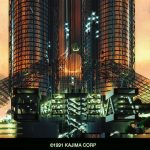
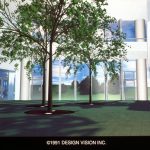
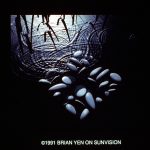

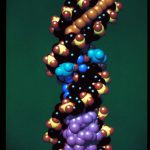
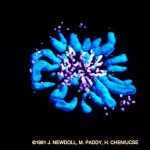
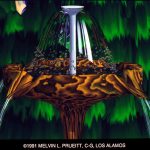
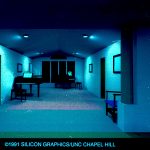
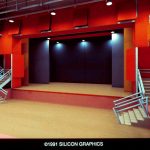
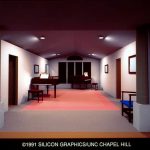
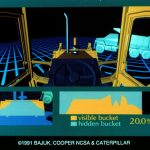
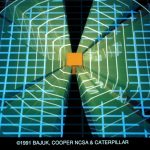
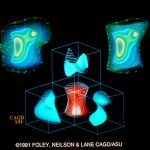
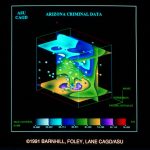
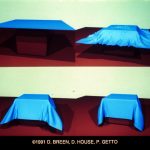
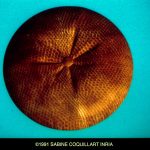
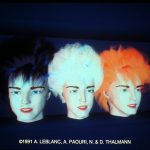
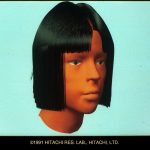
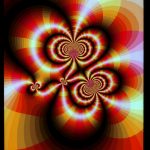
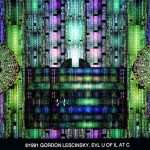

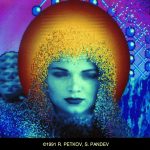
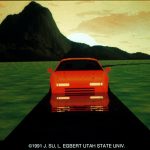

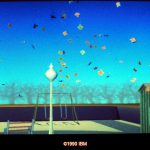
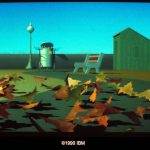

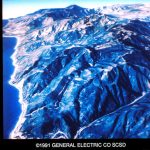
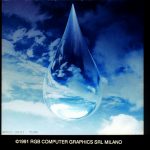
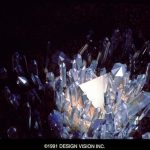
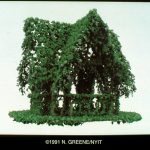
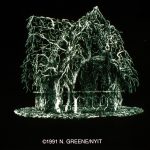

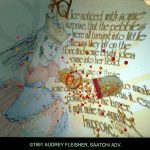
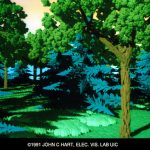
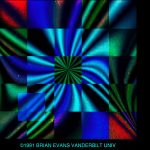
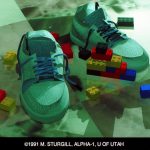
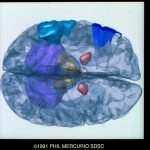
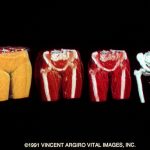
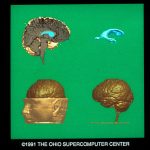
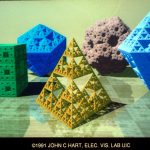
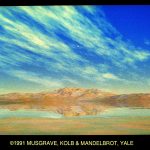
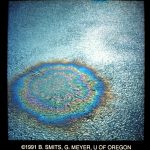
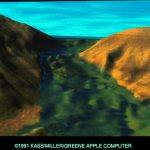
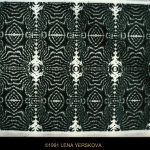


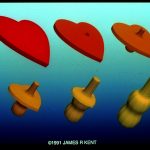
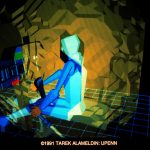
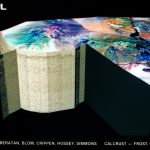
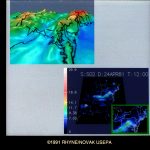
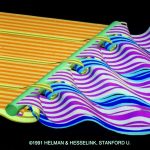
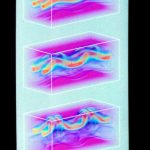
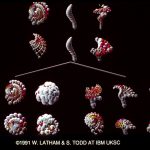
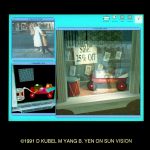
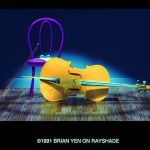
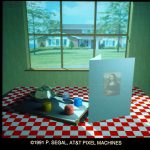

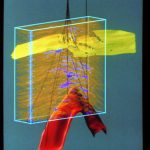
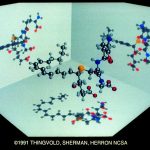
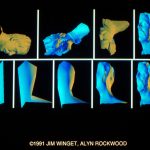
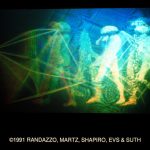

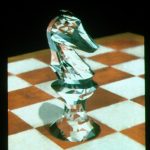
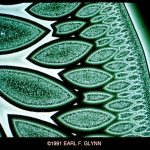
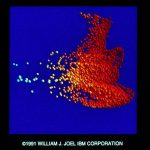
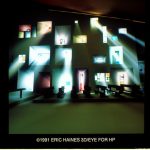
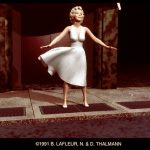
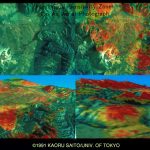
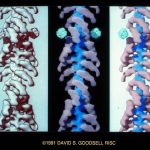
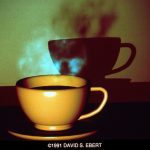
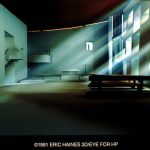

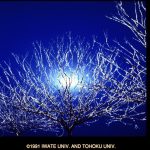
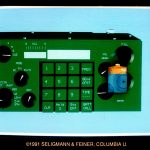
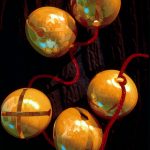

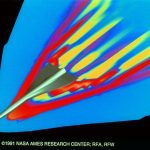
Additional Information:
1. DIB-200 Atrium by Shinichi Kasahara, A. Scott Howe. Computed at a resolution of 2048×1376. The number of point light sources is 212. The number of polygons is about 41000. Calculation time is about 9 hours. Software: Modeling by CATIA 3D CAD system; Rendering by REALS in-house ray tracing software. Hardware: Modeling on IBM 3090 mainframe; Rendering on MAGIC high-speed graphics engine. Contact: Shinichi Kasahara, Kajima Corporation Information Processing Center, 6-5-30 Akasaka Mianto-ku, Tokyo 107, Japan, (03) 5561-2403.
2. IBM 3600 Steeles Atrium by Mary Lynn Machado. The architectural and background information were created using Alias 3D. The trees were created using AMAP 3D plant generating software. AMAP, running on SGI workstations, creates biologically correct plant species. Lighting and POV’s were matched to the Alias image. The trees were rendered in AMAP and composited with Alias. Software: Alias Version 2.4.2, AMAP Landscape Software. Hardware: SGI 4D/25, SGI 4D/70, IBM RISC 6000. Contact: Mary Lynn Machado, Design Vision Inc., 479 Wellington St. West, Toronto, ON, Canada M5V 1E7, (416) 585-2020.
3. Pond by Brian Yen. Dynamic wave simulations for a rainy night. Software: Sunvision. Hardware: Sun 4/470. Contact: Brian Yen, Sun Microsystems Inc., 2550 Garcia Ave., Mountain View, CA 94043-1100, (415) 336-6509.
4. Neural Network Reconstruction by Rei Cheng. Side view, 3D reconstruction of several neurons within a balance organ of the inner ear, based on tracings from 234 serial section electron micrographs. The research addresses issues related to space and motion sickness problems. Software: Ross 2.2 system developed at NASA Ames. Hardware: SGI 4D/VGX, Dunn 635 camera. Contact: Rei Cheng, Biocomputation Laboratory MS 239-11, NASA Ames Research Center, Moffett Field, CA 94035.
5. Chimera by TA. Larsen, D.S. Goodsell. Three independently solved DNA-ligand complexes were combined into a single chimeric structure to illustrate three types of interactions with DNA. Software: Raster Molecular Surface. Hardware: Evans and Sutherland PS390. Contact: TA. Larsen, Molecular Biology Institute, University of California at Los Angeles, 405 Hilgard Avenue, Los Angeles, CA 90024-1570, (213) 206-8270.
6. Chromasomes during Cell division by Julie Newdoll, Hans Chen, David Agard. Transparent ray traced 1/2 of a mitotic spindle during anaphase. Blue = chromasomes, Green = centromeres, Magenta = newly discovered protein which is approximately 60 μm across. Software: Presolid and Rendach (uses Dore). Hardware: Stardent Titan, VAX. Contact: Julie Newdoll, University of California at San Francisco, Department of Biochemistry, Box 0448, San Francisco, CA 94143-0448, (415) 665-1428.
7. Fountain Closeup by Melvin L. Prueitt. Closeup view of Fountain in “A Garden on Vega Nine”. Water film and streams follow appropriate gravitational trajectory. Software: SCOPE (author’s own program). Hardware: Cray YMP, Dicomed Film Recorder. Contact: Melvin L. Prueitt, C-6 Computer Graphics, MS-B272, Los Alamos National Laboratory, Los Alamos, NM 87545, (505) 667-4452.
8. Stage View – Candlestick Theater by Dan Baum, Steve Mann, Kevin Smith, Jim Winget, Mark Mack, Charles Ehrlich (UC Berkeley). This image was generated using techniques from the paper entitled “Making Radiosity Usable: Automatic Preprocessing and Meshing Techniques for the Generation of Accurate Radiosity Solutions”. Software: Prototype radiosity preprocessing, solution, and viewing software. Hardware: SGI 4D/320VGX. Contact: Dan Baum, Silicon Graphics, 2011 N. Shoreline Blvd., MS7U-550, Mountain View, CA 94039-7311, (415) 962-3671.
9. Auditorium View – Candlestick Theater by Dan Baum, Steve Mann, Kevin Smith, Jim Winget, Mark Mack, Charles Ehrlich (UC Berkeley). This image was generated using techniques from the paper entitled “Making Radiosity Usable: Automatic Preprocessing and Meshing Techniques for the Generation of Accurate Radiosity Solutions”. Software: Prototype radiosity preprocessing, solution, and viewing software. Hardware: SGI 4D/ 320VGX. Contact: Dan Baum, Silicon Graphics, 2011 N. Shoreline Blvd., MS7U-550, Mountain View, CA 94039-7311, (415) 962-3671.
10. Brooks’ House Living Room by Dan Baum, Steve Mann, Kevin Smith, Jim Winget. This image was generated using techniques from the paper entitled “Making Radiosity Usable: Automatic Preprocessing and Meshing Techniques for the Generation of Accurate Radiosity Solutions”. The building model is copyright UNC at Chapel Hill. Software: Prototype radiosity preprocessing, solution, and viewing software. Hardware: SGI 4D/320VGX. Contact: Dan Baum, Silicon Graphics, 2011 N. Shoreline Blvd., MS7U-550, Mountain View, CA 94039-7311, (415) 962-3671.
11. Visibility Analysis of a Front Loading Work Cycle by Mark Bajuk, David Cooper (Caterpillar, Inc.). A combination of viewing windows, from a “multi-eyed” wide angle camera to a flat shaded bucket-tracking camera, are used to analyze the visibility of a backhoe front bucket during a truck-loading work cycle. Software: Wavefront Technologies and various in-house visualization software. Hardware: SGI 4D/240GTX. Contact: Mark Bajuk, NCSA at the University of Illinois at Urbana-Champaign, 605 E. Springfield Ave., Champaign, IL 61820, (217) 244-1996.
12. The Light Bulb Shadow Test by Mark Bajuk, David Cooper (Caterpillar, Inc.). A computer graphic re-creation of the light bulb shadow test. A bulb is placed at the vehicle operator’s eye point, casting cones of light out through the windows of the cab. Software: Wavefront Technologies and various in-house visualization software. Hardware. SGI 4D/240GTX. Contact: Mark Bajuk, NCSA at the University of Illinois at Urbana-Champaign, 605 E. Springfield Ave., Champaign, IL 61820, (217) 244-1996.
13. Hypersurface Projection Graphs by T. Foley, G. Nielson, D. Lane. A new method for modeling a hypersurface defined on a surface is visualized using orthogonal, radial and three 4D hypersurface projections. Software: Authors’ original software. Hardware: SGI 4D/340VGX. Contact: T. Foley, CAGD Research Group, Computer Science Department, Arizona State University, Tempe, AZ 85287-5406, (602) 965-3190.
14. Visualizing Criminal Data by Barnhill, Foley, Lane, Woodland. Visualizing self control as a function of manic, depression, and psychopathic deviance. Software: Authors’ original software. Hardware: SGI 4D/340VGX. Contact: Wayne B. Woodland, CAGD Research Group, Computer Science Department, Arizona State University, Tempe, AZ 85287-5406, (602) 965-3190.
15. Cloth Draping Simulation (0, 4.5, 9,14) by David Breen, Donald House, Phillip Getto. This slide represents four instances in a draping cloth simulation using a particle-based modeling technique. Software: The Clockworks. Hardware: DECstation 3100, SGI 4D/60. Contact: David E. Breen, Rensselaer Design Research Center, Cll 7015, RPI, Troy, NY 12180-3590, (518) 276-6482.
16. A leather cushion by Sabine Coquillart. This slide shows the Extended Free-Form Deformation technique. A leather cushion obtained by deforming a surface of revolution is shown. Software: ACTION 3D . Hardware: SGI 4D/ 20. Contact: Sabine Coquillart, INRIA, Domaine de Voluceau, BP 105, 78153 Le Chesnay Cedex, France, (33) 1-39-63-54-23.
17. Hair by André Leblanc, Arghyro Paouri, Nadia Magnenat Thalmann, Daniel Thalmann . Hair generation using pixel blending (about 80000 hairs per character). Software: Human Factory, Hairdresser. Hardware: SGI 4D/ 240VGX. Contact: Daniel Thalmann, Computer Graphics Lab, Swiss Federal Institute of Technology, CH-1015 Lausanne, Switzerland, 41-21-693-5214.
18. Hairdressing Simulation by Ken-ichi Anjyo, Yoshiaki Usami, Ryozo Takeuchi. A simple deformation model of cantilever beams brings variations of hairdo, along with an anisotropic reflection model for 3D curves. SoftwareJn- house software for human action generation. Hardware: SGI 4D/210VGX. Contact: Ryozo Takeuchi, Hitachi Research Laboratory, Hitachi Ltd., 4026 Kuji-cho, Hitachi-shi, Ibaraki-ken 319-12, Japan, 81-294-52-5111.
19. Phase Portrait by Scott A. Burns. This image presents a phase portrait and time parameterization of an autonomous differential equation, produced using an operational method called the “Newton transform” (Physica D, 37 (1989) 83-90). The Newton transform generates integral curves with no propagated error by identifying constants of motion – even in non-conservative systems where energy integrals produced by quadrature do not exist. Software: Custom Fortran. Hardware: Macintosh, Matrix SlideWriter. Contact: Scott A Burns, University of Illinois at Urbana-Champaign, 104 S Mathews #117, Urbana, IL 61801, (217) 333-1618.
20. Garish by Gordon Lescinsky. Linear fractals with partially randomized production rules rendered in a parallel environment. The algorithm used is akin to Escape Time Algorithm as used to render iterated function systems. Software: Original C program. Hardware: AT&T Pixel Machine. Contact: Gordon Lescinsky, Electronic Visualization Laboratory, EECS Department, M/C 154, University of Illinois at Chicago, Chicago, IL 60680-4348, (312) 996-3002.
21. Space Mind by Rossen Petkov, Stilian Pandev. This slide shows harmony between life and non-life objects in the universe. It is composed from scanned faces, fractals, and other computer graphic effects. Software: Autodesk Animator. Hardware: IBM PS & Super VGA. Contact: Rossen Petkov, g.k. ‘Chervena zvezda’ bl.10 vh.B ap.54, BG-1172 Sofia, Bulgaria.
22. Mirage at Sunset I by Jin Su, Larre Egbert. Rays were traced through the refractive index gradient created by the hot road surface. Software: C compiler only. Hardware: HP 9000. Contact: Larre Egbert, Utah State University, Computer Science Department, Logan, UT 84322-4205, (801) 750-3280.
23. Wave Functions by Melvin L. Prueitt. These are wave functions around atoms. Data supplied by Mark Eberhart. Software: SCOPE (author’s own program). Hardware: Cray YMP, Dicomed Film Recorder. Contact: Melvin L. Prueitt, C-6 Computer Graphics, MS-B272, Los Alamos National Laboratory, Los Alamos, NM 87545, (505) 667-4452.
24. Electron density of chlorophyll dimer by Susumu Handa, Toshihiro Sakuma, Toshikazu Takada. This image shows the electron density of the chlorophyll dimer. Coordinates are determined by J. Deisenhofer et al. AMOSS, ab inito molecular orbital calculation program developed by the NEC quantum chemistry group, was used to obtain the electron density data. The image was generated using vrms, which is an in-house volume rendering program. The first version of vrms was developed by Susumu Handa during his stay at Dr. Olson’s lab of the Research Institute of Scripps Clinic. The iso-surfaces and cloud of density are shown with the mist effect. The inside of the molecule can be seen through the cross-section. Software: vrms (in-house volume rendering program). Hardware: Stardent (Titan) 3000. Contact: Susumu Handa, NSIS & NEC Corporation, 34 Miyukigaoka, Tsukuba, Ibaraki 305 Japan, 298-56-6155.
25. Geospecific Color Cell Texture by Rosalie Bibona & Advanced Engineering Dept. Color cell texture flying in real-time with variable density terrain. The texture resolution is composed of 20 foot/cell hand held aerial photographs of Malibu, California. Hand held aerials and LANDSAT imagery were geometrically corrected, mosaiced, color balanced, and formatted prior to IG loading – commonly known to GE as “Photovisual databases”. Software: “Target DBGS” – GE in-house Database Generation System used to construct the database prior to Image Generator (IG) loading for Compu-Scene VI. The software is written in C++, based on an object-oriented design. The graphics display software is based on the X-windowing system. Hardware: Compu-Scene VI Real Time Flight Simulator. Contact: Rosalie Bibona, General Electric/Simulation & Control Systems Department, 1800 Volusia Avenue, Daytona Beach, FL 32114, (904) 239-2045.
26. Mission Accomplished by Rosalie Bibona & Advanced Engineering Dept. The scene depicts the first generation “Photovisual” system for mission rehearsal training. The MH53J 3D model is composed of approximately 800 faces and one 512×512 monochrome cell map. The terrain database is composed of 80 512×512 monochrome maps with geospecific 3D models of Pahrump, Nevada. Software: “Target DBGS” – GE in house Database Generation System. Hardware: Compu-Scene V Real Time Flight Simulator. Contact: Rosalie Bibona, General Electric/Simulation & Control Systems Department, 1800 Volusia Avenue, Daytona Beach, FL 32114, (904) 239-2045.
27. Poised for the Chase by Kavi Arya, Bob Bacon, Dave Haumann, Al Khorasani, Alan Norton, Paula Sweeney, Jakub Wejchert. Physically based simulation of leaves blowing in the wind. Software: AIX. Hardware: IBM RS/6000, SGI 4D/70GT, IBM 3081. Contact: David R. Haumann, IBM T.J. Watson Research Center, 30 Saw Mill River Road, Hawthorne, NY 10532, (914) 784-7013.
28. Leaf Ballet by Kavi Arya, Bob Bacon, Dave Haumann, Al Khorasani, Alan Norton, Paula Sweeney, Jakub Wejchert. Physically based simulation of leaves blowing in the wind. Software: AIX. Hardware: IBM RS/6000, SGI 4D/70GT, IBM 3081. Contact: David R. Haumann, IBM T.J. Watson Research Center, 30 Saw Mill River Road, Hawthorne, NY 10532, (914) 784-7013.
29. Goccia by Hidveghy Juray. 3D drop with reflection mapping of the sky. Software: Lumena, Crystal 3D. Hardware: Vista. Contact: RGB Computer Graphics srl, viale Piave, 17 – 20129 Milano, (39) 02-78-39-92.
30. Crystals of Light by Semannia Luk Cheung. This image is a still image from an animation. Ray tracing was used to produce realistic refraction and reflection but it has difficulty producing certain lighting effects. The glow at the centre was achieved with the use of transparency mapping. Software: Alias Version 2.4.2. Hardware: SGI 4D/ 25, SGI 4D/70, IBM RISC 6000. Contact: Semannia Luk Cheung, Design Vision Inc., 479 Wellington St. West, Toronto, ON, Canada M5V 1E7, (416) 585-2020.
31. Organic Architecture by Ned Greene (NYIT). Created with modeling automata that track a crude geometric model as described in “Voxel Space Automata” in the SIGGRAPH ’89 Proceedings. Software: In-house gaudi growth program. Hardware: Sun 4. Contact: Ned Greene, Apple Computer MS-60W, 20525 Mariana Ave., Cupertino, CA 95014, (408) 974-9491.
32. Winter by Ned Greene (NYIT). Stochastic detailing of a crude model with voxel automata. Software: In-house gaudi growth program. Hardware: Sun 4. Contact: Ned Greene, Apple Computer MS-60W, 20525 Mariana Ave., Cupertino, CA 95014, (408) 974-9491.
33. Fractal Forest by John C. Hart. Linear fractal pine trees, elm trees and grass are modeled with iterated function systems in 3D, ray traced, and antialiased. Software: Proprietary ray tracer, DEVtools O/S, C language. Hardware: AT&T Pixel Machine #964dX, Sun 4. Contact: John C. Hart, Electronic Visualization Laboratory, EECS Department, M/C 154, University of Illinois at Chicago, Chicago, IL 60680-4348, (312) 996-3002.
34. Alice Gets Small by Audrey Fleisher. Alice was drawn and painted using Tips software, text was generated and composited in RIO software, and finally brought to QFX to complete texture. This picture was mapped to the inside of half an open sphere and placed behind the exploding capsule in CRYSTAL RRS. Software: Vista TIPS, RIO, CRYSTAL RRS, QFX. Hardware: CompuSystems Pacesetter 386. Contact: Audrey Fleisher, Saatchi & Saatchi Advertising, 375 Hudson Street, New York, NY 10014-3620, (212) 463-3722.
35. Bacheca by Gabriella Monti. 3D showcase with some scanned objects and some objects produced in computer graphics and retouched with Lumena. Software: Lumena, Crystal 3D. Hardware: Vista. Contact: RGB Computer Graphics srl, viale Piave, 17 – 20129 Milano, (39) 02-78-39-92.
36. Atonal Tiling by Brian Evans. “Atonal” design with tile distribution and color, further neutralized with a symmetrical ground. Software: Author’s own software. Hardware: Cray YMP, Apple Macintosh llfx. Contact: Brian Evans, Vanderbilt University Computer Center, 105 Stevenson Center, Nashville, TN 37235, (615) 343-1621.
37. Brain Visualization for Schizophrenia Research by Wunjang Shieh, Donald Stredney, Michael Torello. The MRI data set was 256x256x180 in resolution with voxel size 1.1 mm. The regions of interest were extracted using segmentation software. This software is capable of measuring areas and volumes of the extracted data. These images are voxel renderings of the data on a Cray YMP. The software is being used to detect and define brain abnormalities in schizophrenics. Software: In-house MRI Segmentation software and Voxel Rendering Hardware: Sun SPARCstation, Cray YMP 8/864. Contact: Wunjang Shieh, Advanced Computing Center for the Arts and Design, 1224 Kinnear Road, Columbus, OH 43210, (614) 292-3416.
38. Volume CT Study of Female Pelvis by Vincent Argiro, Bill Van Zandt, Maggie Vancik, Murray Foster. Montage of 4 progressively more transparent volume renderings using gradient lighting and gradient magnitude thresholding. Data courtesy of Sarah Gibson (Carnegie-Mellon Univ.) Software: VoxelView/ULTRA. Hardware: SGI 4D/220VGX. Contact: Vincent Argiro, Vital Images Inc., 505 N. 4th, Fairfield, IA 52556, (515) 472-7726.
39. Human Brain: Top View by Phil Mercurio. View of the human brain and its internal structures; from a sectioned, hand-digitized brain. Software: Wavefront Advanced Visualizer. Hardware: SGI 210VGX, Alliant FX80. Contact: Phil Mercurio, San Diego Supercomputer Center, PO Box 85608, San Diego, CA 92186-9784, (619) 534-5126.
40. Childhood Memory by Malgorzata Marek Sturgill. Models of the objects in this image were created using high level modeling operators in the Alpha_1 geometric design system. The soles of the shoes were created using sweep operators. All of the surfaces in the shoes are either ruled or boolean surfaces. Bumps and waves on the shoe surface were created using a “region warp” operator. The shoe laces were modeled by creating a uniform cubic spline along the path of each lace, scaling it in Z dimension, sweeping a circle along the path of the curve, and then scaling down the original position. This produces a flattened surface. Toy building blocks were created by unioning cylinders with rectangular boxes. Software: Alpha_1. Hardware: SGI 4D/240GTX. Contact: Malgorzata Marek Sturgill, 3190 MEB, Computer Science Department, University of Utah, Salt Lake City, UT 84112, (801) 581-8354.
41. Frame from “Splash Dance” by Mike Kass, Gavin Miller, Ned Greene. Frame from the animation “Splash Dance” illustrating simulated fluid flow. The animation was shown in the SIGGRAPH ’90 Film and Video Show and the method is described in the SIGGRAPH ’90 proceedings. Software: In-house. Hardware: SGI 4D/320. Contact: Ned Greene, Apple Computer, 20525 Mariani Ave., Cupertino, CA 95014, (408) 974-9491.
42. Light interference in an oil slick by Brian Smits, Gary Meyer, Mark VandeWettering. Newton’s colors produced by light interference in an oil slick on wet pavement. Light modeled on a wavelength basis and converted to tristimulus values for display. Software: Wavelength based ray tracer employing Perlin textures. Hardware: Sun SPARCstation and SGI workstation. Contact: Gary W. Meyer, Department of Computer and Information Science, University of Oregon, Eugene, OR 97403, (503) 346-4413.
43. Mirage by F.K. Musgrave, C.E. Kolb, B.B. Mandelbrot. This image was conceived as an illustration for an article in the November 1990 issue of IEEE Computer Graphics and Applications. It illustrates a mirage model, novel fractal clouds created using stretched fractional Brownian motion, and a fractal coloring algorithm. The terrain is modeled using the noise synthesis method; the crescent moon also has fractal features. Software: Rayshade, C- Linda. Hardware: 9 DECstation 5000’s under Network Linda. Contact: Ken Musgrave, Yale University Math Department, Box 2155 Yale Station, New Haven, CT 06520, (203) 432-4016.
44. The Five Non-Platonic Non-Solids by John C. Hart. From left to right: Menger’s Sponge, Sierpinski’s Icosohedron, Sierpinski’s Tetrahedron, Von Koch’s Snowflakeahedron and Sierpinski’s Octahedron. Software: Proprietary ray tracer, DEVtools O/S, C language. Hardware: AT&T Pixel Machine #964dX, Sun 4. Contact: John C. Hart, Electronic Visualization Laboratory, EECS Department, M/C 154, University of Illinois at Chicago, Chicago, IL 60680-4348, (312) 996-3002.
45. Textile Ornament by Lena Yerskova. Software: Author’s own software. Hardware: EGA display. Contact: Lena Yerskova, Moscow Textile Institute, Murokava 9, Moscow 129282, CCCP.
46. Algorithmic Painting (before and after) by Tsuyoshi Yamamoto. Fully algorithmic painting generation from photographs. The image was converted into a painting-like image without interactive retouching. Software: In house C program. Hardware: SPARCstation 1. Contact: Tsuyoshi Yamamoto, Hokkaido University Computing Center, N-11, W-5, Kitaku, Sapporo 060, Japan, (81) 11-716-2111 X2969.
47. Ayatorl (Cat’s Cradle) by Shinichi Takemura. This picture was intended to express woven strings. The color and bump mapping were applied on the string surface. The source file for the bump mapping was carefully calculated from woven models. Special techniques were adopted to avoid the geometric accuracy of a string shape. Software: Author’s own software. Hardware: Sun SPARCstation, Epson PC-386. Contact: Shinichi Takemura, Science University of Tokyo, 1-14-18, Gohongi, Meguro-Ku, Tokyo, 153 Japan, (03) 3712-0856.
48. Heart to Bottle Transformation by James Kent. The slide demonstrates the results of a 3D polyhedral shape transformation algorithm. Given two polyhedral models as input, the algorithm projects the vertex/edge/face network of each onto the surface of the unit sphere, clips the projected faces of one model to the projected faces of the other, then projects the clipped faces back onto the surface of each original model. The clipped faces provide a one-to-one correspondence between the vertices, edges, and faces of the two models which is used in interpolating from one to the other. Software: Custom transformation and rendering software. Hardware: Sun 4. Contact: James Kent, Department of Computer and Information Science, The Ohio State University, 2036 Neil Avenue, Columbus, OH 43210, (614) 292-1033.
49. Human Reach Volume in Apache Helicopter by Tarek Alameldin. Yellow volume is extent of workable reach space (using shoulder) in Apache helicopter. Software: Reach space software by author. Hardware: SGI IRIS. Contact: Tarek Alameldin, University of Pennsylvania Computer Graphics Lab, 200 South 33rd St., Philadelphia, PA 19104-6389, (215)898-1976.
50. Turtle Mountains Crustal Block by Gloria Brown-Simmons. Processed LANDSAT and seismic data rendered with a terrain model. Surface colors and shapes assist researchers in locating high-angle faults. Seismic data reveals the complex series of low-angle faults. Software: VICAR (Image Processing System) & Wavefront. Hardware: SGI 3030, Alliant FX8, VAX 3650. Contact: Gloria Brown-Simmons, JPL/Caltech MS 168-514, 4800 Oakgrove Drive, Pasadena, CA 91109, (818) 354-4370.
51. Ozone Peaks/SO2 Depositions by Theresa Rhyne, Joan Novak. High ozone concentrations are depicted using a mountain plot representation. SO2 depositions of the eastern half of the USA are shown with a highlight of part of the northeast region below. Data is from the Regional Acid Deposition Model. Software: Custom rendering software from Numerical Design Limited. Hardware: SGI Personal Iris, Solitaire Film Recorder (courtesy of North Carolina Supercomputer Center). Contact: Theresa Rhyne, US EPA Scientific Visualization Lab/US EPA MD-34C, Research Triangle Park, NC 27709, (919) 541-0207.
52. Topology Visualization: 2D Circular Cylinder by James L. Helman, Stuart Rogers (NASA Ames), Dochan Kwak (NASA Ames). Surfaces depict the time evolution of the topology of a 2D flow past a circular cylinder through several periods of vortex shedding. Software: Custom data visualization software. Hardware: SGI 4D/220GTX. Contact: James L. Helman, c/o Aero/Astro Department, Stanford University, Stanford, CA 94305, (415) 723-9127.
53. Sonic Boom Carpet Beneath Supersonic Transport Concept by Tom Edwards, Samson Cheung, Scott Lawrence, Vee Collet. The pressure field beneath a supersonic airplane shows multiple shock waves that form a sonic boom heard on the ground. Software: Flow Analysis Software Tool Kit. Hardware: SGI 320VGX. Contact: Vee Collet, Sterling Software at NASA Ames, MS 258-2, Moffett Field, CA 94035, (415) 604-4450.
54. Vortex Simulation Time Series by Vincent Argiro, Bill Van Zandt, Christian Tourenne. Three time points in a volume simulation of anti-parallel vortex development; color-opacity volume rendering. Data courtesy of Daniel Meiron (CALTECH). Software: VoxelView/ULTRA. Hardware: SGI 4D/220VGX. Contact: Vincent Argiro, Vital Images Inc., 505 N. 4th, Fairfield, IA 52556, (515) 472-7726.
55. Tree of Recursive Horns (detail) by William Latham, Stephen Todd. An evolutionary tree of recursive horns produced using “Mutator” program which uses “artist controlled natural selection” and random mutation of parameters. Used for producing sculptural forms. Software: Winsom and Esme (CSG modeling software). Hardware: IBM 3081 with IBM 6090 display. Contact: William Latham, IBM UK Scientific Centre, St. Clement Street Winchester, Hampshire SO23 9DR UK, (0962) 844191.
56. Flames by Masa Inakage. Flames are rendered by volume tracing that accounts for flaming process by chemical reactions. Software: Original volume rendering software. Hardware: NEC PC-9801 VX2 personal computer. Contact: Masa Inakage, The Media Studio Inc., 3-5-17 Aobadai #303, Meguro, Tokyo 153, Japan, (03) 3496-7294.
57. BCE Place Galleria by Mary Lynn Machado. Numerous types of mapping and lighting techniques were utilized to achieve the high photo-realistic style. The large model size required that the computer’s swap space be increased to 150Mb for rendering purposes. Software: Alias Version 2.4.2. Hardware: SGI 4D25, SGI 4D70, IBM RISC 6000. Contact: Mary Lynn Machado, Design Vision Inc., 479 Wellington St. West, Toronto, ON, Canada M5V1E7, (416) 585-2020.
58. Mona’s Suburban Café by Peter Segal. Radiosity solution is applied to reflect sun light off the back of the menu onto the cups and tray. Scene is then ray traced to add highlights, reflections, and transparency. Total time including up to 9 antialiasing samples for the 1024×1024 image is under 20 minutes. Software: RAYlib integrated ray tracing and radiosity library. Hardware: AT&T Pixel Machine model 964, Solbourne workstation. Contact: Peter Segal, AT&T Pixel Machines Room 2M333, Crawfords Corner Road, Holmdel, NJ 07733, (908) 949-1244.
59. Mellow Yellow Cello by Brian Yen. Software: Rayshade (public domain raytracer from Yale). Hardware: Sun 4/ 470, Sun 4/490, Sun 4/390. Contact: Brian Yen, Sun Microsystems Inc., 2550 Garcia Ave., Mountain View, CA 94043-1100, (415) 336-6509.
60. Toy Store by D. Kubel, M. Yang, B. Yen. Not ray traced. All scanline based rendering. Software: Sunvision. Hardware: Sun 4/490. Contact: Brian Yen, Sun Microsystems Inc., 2550 Garcia Ave., Mountain View, CA 94043-1100, (415) 336-6509.
61. Seaons Greetings by Renee Sauickie. Illustration employing various levels of ray tracing to create photorealistic look. Software: Alias, Artisan. Hardware: SGI 4D/25, SGI 4D/240S. Contact: Renee Sauickie, Production Masters Inc., 321 First Ave., Pittsburgh, PA 15222, (412) 281-8500.
62. Reconstructing 3D Object from 2D Images by Jim Winget, Alyn Rockwood, Wayne B. Woodland. Software: Authors’ original software. Hardware: SGI 4D/70GT. Contact: Wayne B. Woodland, CAGD Research Group, Computer Science Department, Arizona State University, Tempe, AZ 85287-5406.
63. Shape Evaluation of a Leakotriene Molecule by Jeffrey A. Thingvoid, William R. Sherman, David K. Herron. A technique using colored shadows is used to aid the molecular dynamics researcher in determining the shape of a molecule. Software: Wavefront Advanced Visualizer and various in-house software. Hardware: SGI 4D/240GTX. Contact: Jeffrey Thingvoid, NCSA at the University of Illinois at Urbana-Champaign, 605 E. Springfield Ave, Champaign, IL 61820, (217) 244-1996.
64. Seismic Volume with Well Logs by Vincent Argiro, Francis Mosse, Jim Stevens. Volume rendering with concurrent 3D scan conversion of geometric database. Software: VoxelView/ULTRA with embedded geometry option Hardware: SGI 4D/220VGX. Contact: Vincent Argiro, Vital Images Inc., 505 N 4th, Fairfield, IA 52556, (515) 472-7726.
65. Fractal Cells by Earl F. Glynn. Pictured here are unusual fractal “cells” from a 33X magnification of the Julia set z —> z1.5 – 0.2. Software: Turbo Pascal. Hardware: PC AT clone with math coprocessor, VGA monitor, Nikon 4004 camera. Contact: Earl F. Glynn, 10808 West 105th Street, Overland Park, KS 66214-3057, (913) 492-2970.
66. Glass Knight by Satoshi Naito. Ray traced solid glass model. The knight is modeled by 840 triangles. Software: Proprietary ray tracing software. Hardware: Epson personal computer PC-286VS. Contact: Satoshi Naito, Kyodo News Service Computer Section, 2-2-5, Toranomon, Minato-ku, Tokyo 105, Japan, (03) 3584-4111.
67. Fountain by Mark Hall. New technique for animating fluid motion that allows physical simulations of fluid motion which are (hopefully) realistic but which are computationally cheap enough for animators. All fluid motion in this slide was computer derived. The solids in the scene and the sources of fluid (5 jets on the fountain) were specified. The added water caused the top levels of the fountain to overflow, raising the water in the lower tiers, and so on. Software: Author’s own software. Hardware: Stardent Titan. Contact: Mark Hall, Rice University Computer Science, P O Box 1892, Houston, TX 77251-1892, (713) 527-8101 x3820.
68. Dual by D. Randazzo, Paul Martz, Mike Shapiro. White light transmission hologram of 4D wireframe solids, 4D moiré pattern with animated walking figures carrying rocks. Software: Custom. Hardware: Evans & Sutherland EVS 3+. Contact: Paul Martz, Evans & Sutherland, 600 Komas Dr., Salt Lake City, UT 84108, (801) 582-5847 x4711.
69. 2D Attractor in 3D by William J. Joel. Visualization of 2D strange attractors. Software: Proprietary. Hardware: IBM 3090. Contact: William J. Joel, IBM T.J. Watson Research Center, Route 134, Yorktown Heights, NY 10598, (914)945-4183.
70. Ronchamp – Window View by Eric Haines. A rendering of Le Corbusier’s Chapel of Ronchamp; from the north looking at the southern set of windows. Software: HP’s ARCore rendering package and in-house additions. Hardware: HP-Apollo DN10000. Contact: Eric Haines, 3D/Eye Inc., 2359 N. Triphammer Road, Ithaca, NY 14850, (607) 257-1381.
71. Ronchamp – Altar View by Eric Haines. A rendering of Le Corbusier s Chapel of Ronchamp; from the west. Software: HP’s ARCore rendering package and in-house additions. Hardware: HP 9000/835. Contact: Eric Haines, 3D/Eye Inc., 2359 N. Triphammer Road, Ithaca, NY 14850, (607) 257-1381.
72. Hot Tea by David S. Ebert. This slide features volume rendered steam rising from a tea cup, including volume shadowing effects. Software: Volume A-buffer rendering system developed by author. Hardware: HP 9000/370 TSRX. Contact: David S. Ebert, Department of Computer and Information Science, The Ohio State University, 2036 Neil Ave., Columbus, OH 43210, (614) 228-8412.
73. Automatically-Generated Illustration: Ghosted View of Battery in Radio by Dorée Duncan Seligmann, Steven Feiner. Created automatically by IBIS, a rule-based 3D illustration system that takes as input descriptions of objects and a set of communicative goals to be fulfilled. IBIS designs and renders an illustration, generating its viewing specification, objects, rendering styles, and illustrative effects. This illustration was designed to satisfy an input communicative goal to show the location of a radio’s battery. IBIS decided to use a ghosted view of the battery in which objects that would otherwise obscure it are rendered as shaded line-drawings with partial transparency, using an efficient Z-buffer based technique. Software: IBIS (Intent-Based Illustration System). Hardware: HP 9000/ 375 TSRX. Contact: Dorée Duncan Seligmann, 450 Computer Science Building, Columbia University, 500 West 120th St., New York, NY 10027, (212) 854-2736.
74. Decorated Actin – 3 Views by David S. Goodsell. An electron microscope reconstruction, from R. Milligan, is imaged in three ways: left, in an illustration calculated from Z level information; center, in a cloud representation; and right, in a surface representation. The images combine volumetric and procedural objects. Software: In-house software for volume rendering and illustration. Hardware: Convex C240. Contact: David S. Goodsell, Research Institute of Scripps Clinic, 10666 N. Torrey Pines Road MB5, La Jolla, CA 92037, (619) 554-4392.
75. High Visual Sensitivity Zones On An Aerial Photograph by Kaoru Saito. Generating shadow map with digital terrain model, compositing digital images, terrain renderings. The aerial photograph, used as a texture, was prepared by the Geographical Survey Institute of Japan, 1977. Software: Original. Hardware: Sun 4/110C, Pixar II, PC 9801 RAZ. Contact: Kaoru Saito, The University Forests, Faculty of Agriculture, The University of Tokyo, YAYOI 1-1-1, Bunkyo-ku, Tokyo 113, Japan, (03) 3812-2111 x5493.
76. Flashback by Benoit Lafleur, Nadia Thalmann, Daniel Thalmann. Original collision algorithm for cloth animation: a frame of the film “Flashback”. Software: Human factory, cloth software, Rayshade. Hardware: SGI 4D/ 240VGX. Contact: Daniel Thalmann, Computer Graphics Lab, Swiss Federal Institute of Technology, CH-1015 Lausanne, Switzerland, 41-21-693-5214.
77. CG Simulation of Botanical Trees and Flames by Norishige Chiba, Naoyoshi Kanamaru, Kazunobu Muraoka, Kiyoaki Takahashi, Toshiomi Watanabe. The botanical trees are generated by using a growth model having an ability of heliotropism which is developed at Iwate Univ. and Tohoku Univ. The flame is simulated by behavioral models of a 2D vortex and a particle tracer developed at Iwate Univ and Morioka Junior College. Software: In-house experimental growth and behavioral modeling programs and ray tracer. Hardware: Toshiba AS4110 workstation, NEC personal computer PC9801 VX, SIG frame buffer 501FB, AVIO film recorder FR-1000. Contact: Norishige Chiba, Department of Computer Science, Faculty of Engineering, Iwate University, Morioka 020, Japan, 0196-23-5171.
78. CG Simulation of Botanical Trees by Norishige Chiba, Naoyoshi Kanamaru, Kiyoaki Takahashi. The botanical trees are generated by using a growth model having an ability of heliotropism which is developed at Iwate Univ. and Tohoku Univ. Software: In-house experimental growth modeling program and ray tracer. Hardware: Toshiba AS4110 workstation, NEC personal computer PC9801 VX, SIG frame buffer 501 FB, AVIO film recorder FR-1000. Contact: Norishige Chiba, Department of Computer Science, Faculty of Engineering, Iwate University, Morioka 020, Japan, 0196-23-5171.
Publication Type:
Publication Sub-Type:
Contributed By:
- Pete Segal
Location:
- In the collection of Pete Segal




